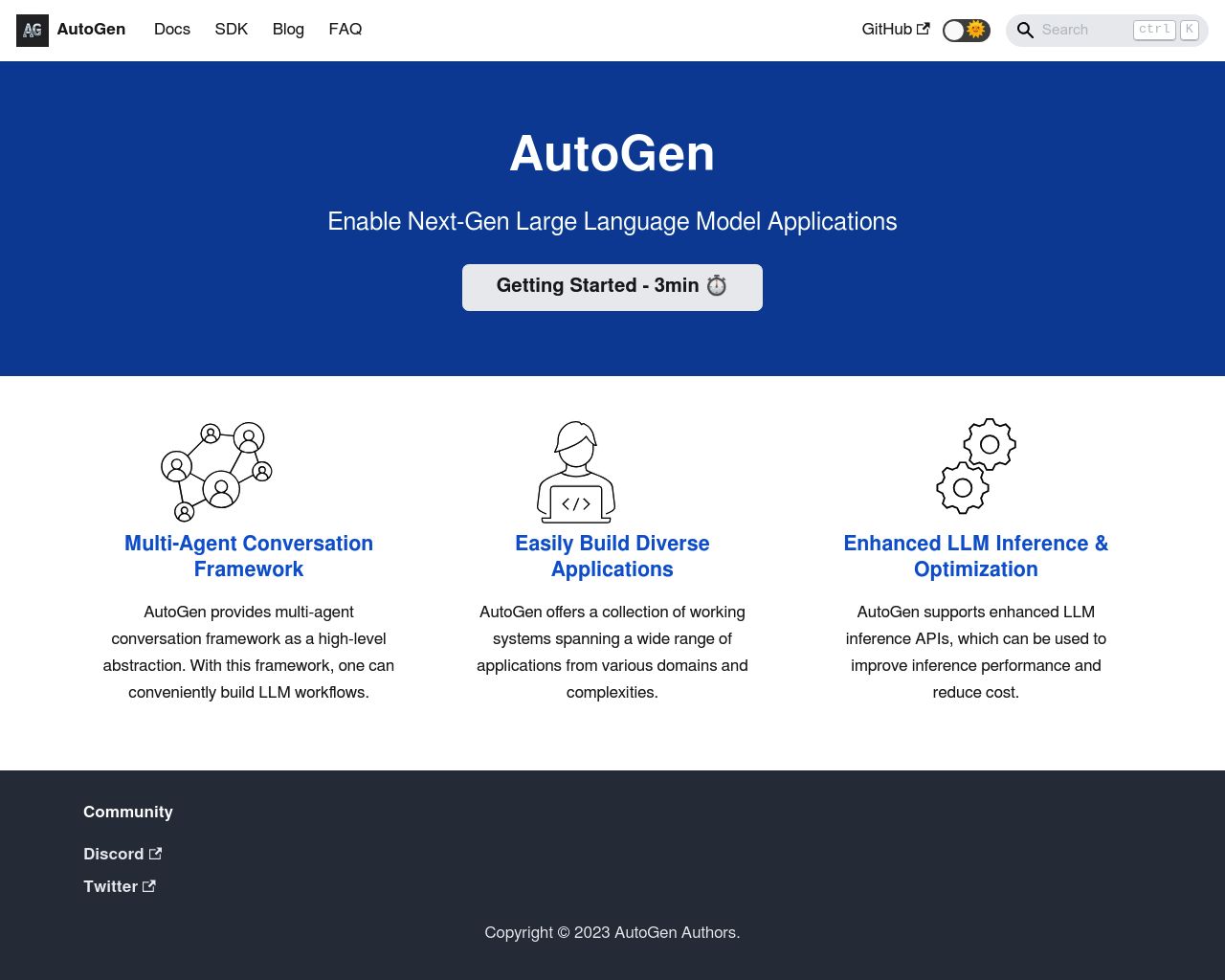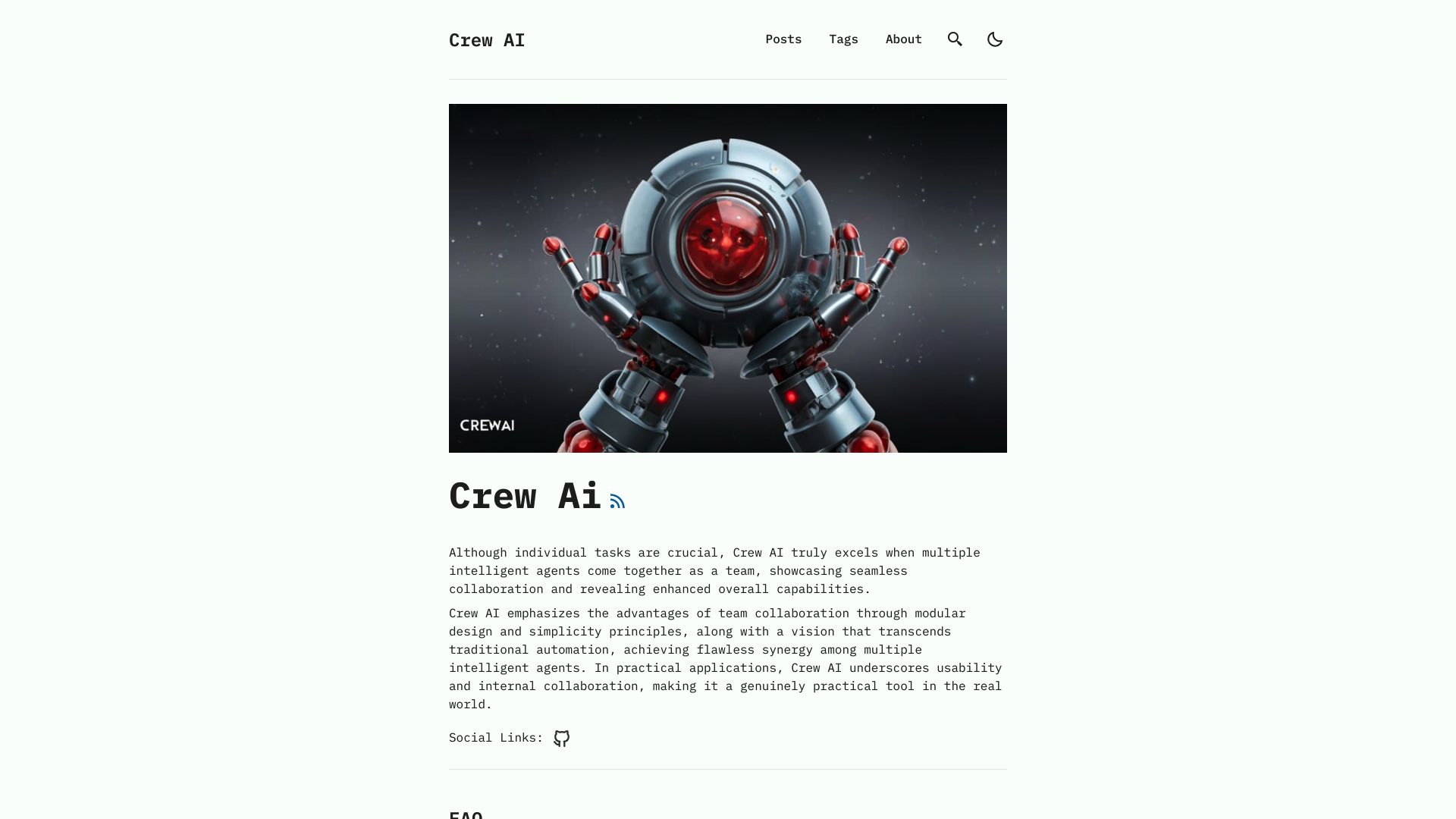AI agent development frameworks revolutionize how we harness machine intelligence for complex problem-solving. AutoGen and CrewAI, two prominent open-source solutions, offer unique approaches to building collaborative AI systems. AutoGen excels in multi-agent conversations and enhanced LLM performance, while CrewAI focuses on role-based agent design and structured workflows. This comparison explores their key features, strengths, and limitations, contrasting them with SmythOS—a comprehensive platform that bridges the gap between technical prowess and user-friendly design. We’ll examine how each solution tackles AI agent creation, deployment, and management, helping you navigate the landscape of AI development tools to find the best fit for your projects and organizational needs.
AutoGen Overview
AutoGen empowers developers to create sophisticated Large Language Model (LLM) applications through multi-agent conversations. This open-source framework enables customizable agents to interact with each other, LLMs, tools, and humans to tackle complex tasks.

AutoGen’s core strength lies in facilitating autonomous multi-agent collaborations. These agents can work together to solve problems, generate code, and engage in continuous learning processes. The framework maximizes LLM performance through advanced inference capabilities, including tuning, caching, error handling, and templating.
AutoGen empowers developers to create sophisticated Large Language Model (LLM) applications through multi-agent conversations… enabling customizable agents to interact with each other, LLMs, tools, and humans to tackle complex tasks.
Developers can tailor agents to specific tasks, integrating LLMs, human inputs, and various tools. AutoGen supports both fully autonomous operations and human-in-the-loop problem-solving, offering flexibility for applications where human oversight is crucial.
The framework demonstrates versatility across diverse applications, from automated task solving to complex problem-solving in group chats. It provides essential debugging tools and logging functionalities for API calls, enabling developers to optimize LLM-based systems effectively.
While AutoGen offers powerful capabilities for LLM applications, it requires coding knowledge for setup and configuration. The lack of a visual builder or no-code editor may present a barrier for non-technical users seeking to leverage its advanced features. Additionally, the framework’s focus on code-based interactions might limit its accessibility for those preferring graphical interfaces for agent creation and workflow management.
CrewAI Overview
CrewAI empowers developers to orchestrate collaborative AI agent teams for tackling complex tasks. This open-source framework enables the creation of specialized agents with defined roles, goals, and skills to work together in structured workflows.

CrewAI’s Python library allows developers to configure AI agents, assign specific tasks, and manage their collaboration through customizable processes. The framework excels in role-based agent design, flexible task delegation, and process-driven workflows that ensure coordinated teamwork between agents.
CrewAI empowers developers to orchestrate collaborative AI agent teams for tackling complex tasks. This open-source framework enables the creation of specialized agents with defined roles, goals, and skills…
Key features include human-in-the-loop integration, allowing agents to incorporate human input when needed. CrewAI also supports autonomous agents that can operate independently to complete tasks, enhancing efficiency in complex problem-solving scenarios.
While CrewAI offers powerful capabilities for multi-agent collaboration, it lacks a visual builder or no-code editor. This limitation may present challenges for non-technical users seeking to create AI agent systems without coding expertise. However, for developers comfortable with Python, CrewAI provides a flexible and extensible platform for building sophisticated AI agent teams.
CrewAI’s modular, open-source architecture encourages community contributions, potentially expanding its capabilities over time. As the framework evolves, it aims to become a robust platform for collaborative AI development, fostering creative applications across various industries and use cases.
Feature Comparison
AutoGen and CrewAI offer distinct approaches to AI agent development, with notable feature gaps in core components and security. AutoGen excels in multi-agent conversations and enhanced Large Language Model inference, providing sophisticated debugging tools and logging functionalities. It supports autonomous agent operations with optional human involvement, making it adaptable for various complex tasks.
CrewAI, on the other hand, focuses on role-based agent design and flexible task delegation within structured workflows. It emphasizes human-in-the-loop integration and process-driven collaboration between specialized agents. However, CrewAI lacks some of AutoGen’s advanced features like enhanced Large Language Model inference and extensive debugging capabilities.
Both frameworks require coding knowledge, lacking visual builders or no-code editors that SmythOS offers. This limitation restricts accessibility for non-technical users. Additionally, neither provides comprehensive security features like data encryption or IP control, which are crucial for enterprise-level deployments. SmythOS addresses these gaps with its intuitive drag-and-drop interface, pre-built API integrations, and robust security measures, making it a more versatile and user-friendly option for AI agent development across various skill levels and use cases.
Feature Comparison Table
| AutoGen | CrewAI | SmythOS | |
|---|---|---|---|
| CORE FEATURES | |||
| Hosted Agents (Dev, Production) | ✅ | ❌ | ✅ |
| Environments (Dev, Production) | ✅ | ❌ | ✅ |
| Visual Builder | ❌ | ❌ | ✅ |
| No-Code Options | ❌ | ❌ | ✅ |
| Explainability & Transparency | ✅ | ❌ | ✅ |
| Debug Tools | ✅ | ❌ | ✅ |
| Multimodal | ✅ | ❌ | ✅ |
| Audit Logs for Analytics | ✅ | ❌ | ✅ |
| Agent Work Scheduler | ❌ | ✅ | ✅ |
| SECURITY | |||
| Constrained Alignment | ❌ | ❌ | ✅ |
| Data Encryption | ✅ | ❌ | ✅ |
| OAuth | ✅ | ❌ | ✅ |
| IP Control | ❌ | ❌ | ✅ |
| COMPONENTS | |||
| Foundation AIs | ✅ | ❌ | ✅ |
| Huggingface AIs | ✅ | ❌ | ✅ |
| Zapier APIs | ✅ | ❌ | ✅ |
| All other APIs, RPA | ✅ | ❌ | ✅ |
| Classifiers | ✅ | ❌ | ✅ |
| Logic | ✅ | ❌ | ✅ |
| Data Lakes | ❌ | ❌ | ✅ |
| DEPLOYMENT OPTIONS (EMBODIMENTS) | |||
| Deploy as API | ✅ | ❌ | ✅ |
| Deploy as Webhook | ✅ | ❌ | ✅ |
| Staging Domains | ❌ | ❌ | ✅ |
| Production Domains | ❌ | ❌ | ✅ |
| API Authentication (OAuth + Key) | ✅ | ❌ | ✅ |
| Deploy as Site Chat | ✅ | ❌ | ✅ |
| Deploy as Scheduled Agent | ❌ | ❌ | ✅ |
| Deploy as GPT | ✅ | ❌ | ✅ |
| DATA LAKE SUPPORT | |||
| Hosted Vector Database | ❌ | ❌ | ✅ |
| Sitemap Crawler | ❌ | ❌ | ✅ |
| YouTube Transcript Crawler | ❌ | ❌ | ✅ |
| URL Crawler | ✅ | ❌ | ✅ |
| PDF Support | ✅ | ❌ | ✅ |
| Word File Support | ✅ | ❌ | ✅ |
| TXT File Support | ✅ | ❌ | ✅ |
Conclusion
AutoGen, CrewAI, and SmythOS each offer unique approaches to AI agent development, catering to different user needs and technical expertise levels. AutoGen excels in facilitating multi-agent conversations and enhancing Large Language Model performance, while CrewAI focuses on role-based agent design and structured workflows. Both frameworks provide powerful capabilities for developers comfortable with coding.
SmythOS, however, stands out as the superior choice for a broader range of users. Its intuitive drag-and-drop interface and no-code editor make AI agent creation accessible to both technical and non-technical users. SmythOS’s extensive integration ecosystem, supporting over 300,000 integrations, allows for seamless incorporation of AI agents into existing workflows and systems.
Unlike AutoGen and CrewAI, SmythOS offers robust security features, including data encryption and IP control, making it suitable for enterprise-level deployments. The platform’s versatility shines through its support for multimodal interactions, problem-solving capabilities, and scalable deployment options — from APIs and chatbots to scheduled agents.
For those looking to harness the power of AI without extensive coding knowledge, SmythOS provides an unparalleled solution. Its comprehensive feature set, user-friendly interface, and focus on security and scalability make it the ideal choice for businesses and individuals seeking to revolutionize their workflows with AI. Explore SmythOS’s diverse range of AI-powered agent templates to jumpstart your AI journey and experience the future of workforce automation today.